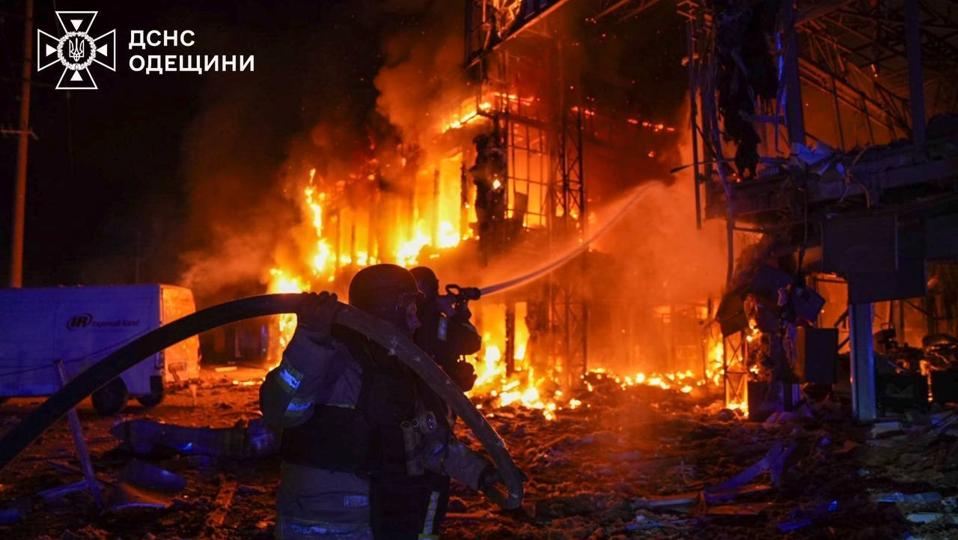In the early stages of the Russia-Ukraine war, many analysts predicted that Russia would rely heavily on hypersonic missiles to strike key Ukrainian targets. However, the use of hypersonics has been fairly limited due to their high cost, supply chain constraints, and modest battlefield effectiveness. As a result, Russia has increasingly turned to loitering munitions in its strategic bombing campaigns. These weapons are inexpensive, flexible, and becoming more advanced. Earlier this month, Ukraine’s Main Directorate of Intelligence of the Ministry of Defence reported the appearance of a new Russian loitering munition known as the Banderol. Its distinguishing feature is the use of a jet engine, unlike other loitering munitions of similar size, which typically rely on piston engines.
The Banderol Loitering Munition
According to Ukrainian officials, the Russian military recently deployed the Banderol in strikes on the Odesa region. The Banderol’s jet engine reportedly allows it to reach speeds between 400 and 500 kilometers per hour, while flying higher and further than traditional loitering munitions. The use of jet engines in such devices is not entirely new. During World War II, Germany developed the V-1 missile, which also relied on a jet engine, although that system lacked the navigational control seen in modern loitering munitions. More recently, the Iranians have developed the Shahed-238 loitering munition, which the Banderol is believed to replicate.
As with any newly deployed military system, many of the Banderol’s technical specifications remain unknown, including its range and payload. The drone appears approximately similar in size to the Geran-2, Russia’s version of the Iranian Shahed-136, suggesting a comparable payload. Meanwhile, its jet engine likely provides an extended range and the ability to fly at higher altitudes. According to the Ukrainian Ministry of Defence, the drone was developed by Kronshtadt JSC and KT Unmanned Systems JSC. Although the exact date of its first use is unclear, sightings have become more frequent over the past month, especially as part of a series of strikes on Odesa.
The Benefit Of Using A Jet Engine
Russia’s decision to use a jet engine on the Banderol is a logical one, as it enables the drone to cover greater distances more efficiently. This extended range allows Russia to strike deeper into Ukraine, including targets in the city of Odesa. Further, the increased range lets Russia launch drones from farther within its own territory, reducing the risk of Ukrainian attacks on airbases and launch sites. Ukraine has been targeting Russian drone staging areas in recent months. The added range not only increases operational flexibility but also makes it harder for Ukraine to anticipate attack patterns.
Another major advantage of the jet engine is that it allows the Banderol to fly at higher altitudes than traditional loitering munitions. Flying at higher elevations helps the drone evade the short-range air defense systems commonly used against such weapons. More significantly, it reduces the drone’s vulnerability to Ukrainian electronic warfare (EW) systems, which currently disable a significant portion of Russian loitering munitions. Since EW signals attenuate with distance, a higher-flying drone is better able to differentiate between jamming signals and its own command and navigation signals.
Russia does have other systems with comparable range and resistance to Ukrainian jamming, such as the Kinzhal hypersonic missile. However, these systems are costly and face production challenges due to Western sanctions. The Banderol should avoid many of these issues, as it appears similar to the Iranian Shahed-236, making it easier to source components from Iran. It also likely shares electronic components with the Geran-2 and other Russian loitering munitions. For the jet engine, Russia can draw on its well-established aviation industry. The current price tag for this drone would be similar to the Shahed-236, which is estimated to cost $1.4M. While more expensive than a piston-based loitering munition, the Banderol is still significant less than a Kinzhal missile, which costs an estimated $1oM.
This relatively low cost is critical. Russia’s current missile strategy relies on overwhelming Ukrainian air defenses with large quantities of projectiles. Further, the introduction of a new loitering munition into strike packages, especially one that flies faster and at different altitudes, will further complicate Ukraine’s ability to detect and neutralize incoming attacks.
Russia appears to be having success with the Banderol, which is not surprising. Its capabilities allow it to bypass many Ukrainian air defenses and strike targets deep within the country. As a result, its use can be expected to increase. However, as with every new technology introduced in this war, these advantages are temporary. As Ukraine adapts its air defense systems and strategies, the Banderol’s effectiveness will diminish. Regardless, the system provides Russia with a valuable capability at a critical point in the war.

